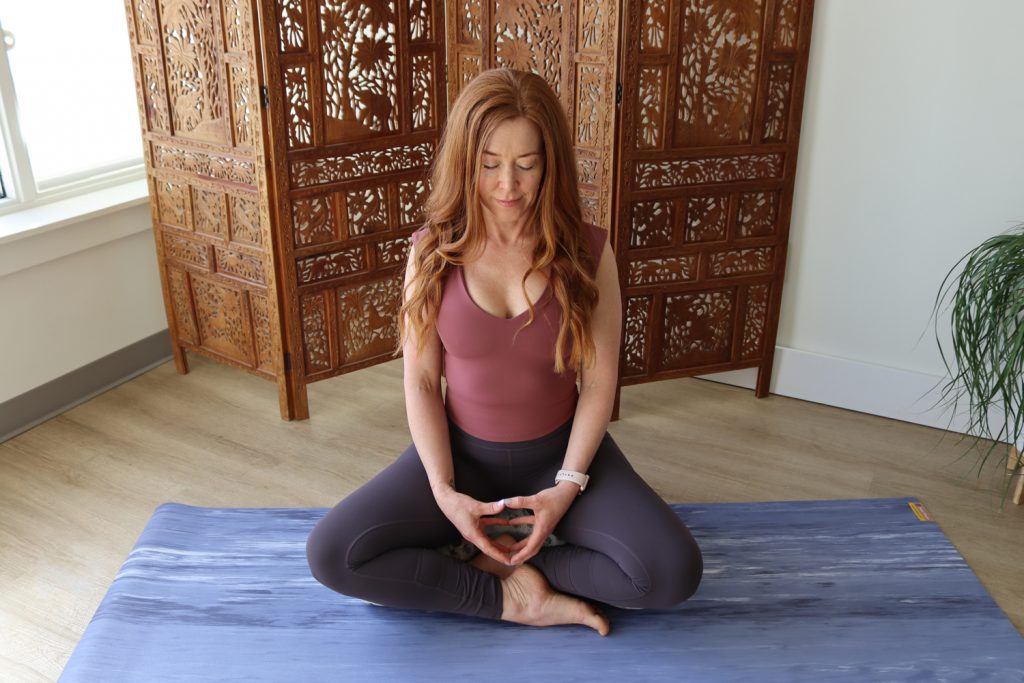Breathe Easy with Hakini Mudra
There’s power in your hands, more than you might think. I was first exposed to hand mudras during iRest (Yoga Nidra) training with Richard Miller, PhD, decades ago. While I knew our hands are highly enervated, and command lots of real estate in the brain’s body maps, I had no idea how easily different hand positions translated to effects in the rest of the body. In Miller’s training, I learned mudras for pranayama, meditation, and positions intended to “light up” each chakra. However, we didn’t practice Hakini Mudra.
Often called “Brain Power Mudra” or “Mudra for the Mind,” Hakini Mudra is said to enhance brain power. According to the yoga tradition, practicing this mudra improves concentration, memory and focus. I learned Hakini Mudra from yoga teacher Jenny Otto, as a position that can give us access to different areas of our “breathing space.”
Why Expand Your Breathing Space?
According to an article in Massage & Bodywork Magazine, “The Science of Mouth vs. Nose Breathing” by John Douillard, the ribcage becomes a literal cage for our lungs and diaphragm over time. Excessive sitting, shallow breathing and sedentary lifestyles all contribute to this problem. When the ribcage becomes rigid, the diaphragm can no longer fully contract when we inhale. As a result, our breathing becomes shallower.
Here’s how Douillard explains it:
”When the diaphragm contracts, it draws oxygen into the lungs, forcing the ribcage to expand. Over time, as the ribcage becomes more rigicl, the diaphragm weakens and cannot fully contract on inhalation and relax on exhalation. This means the breath pattern becomes shallow. Over the years, we are likely to become shallow breathers, engaging in what is called over breathing.
“During shallow breathing, 75 percent of the oxygen we inhale is exhaled unused. Shallow breathing also forces us to breathe out excessive carbon dioxide. In this shallow breathing state, the oxygen levels in the blood stay high while CO2 levels plummet. This is the perfect storm for anxiety, which is why when folks have a panic attack, they try to boost carbon dioxide levels by breathing into a paper bag. While chronic blood levels of excess oxygen and low-carbon dioxide increase the body’s srress response, rising blood levels of carbon dioxide actually have a sedation effect on the body.“
I highly recommend you read the entire article (linked above). It gives vital information about the importance of diaphragmatic breathing. It’s a must for yoga teachers!
How to Practice Hakini Mudra to Expand the Breath
Hakini Mudra can give us access to the lower, middle and upper breathing spaces, simply by how we contact our fingertips.
Begin by finding a comfortable seated position. Make sure you have enough support under your hips so that your spine can rest in its natural curves. Here’s an article with suggestions for determining the best meditation cushion for your body. You can also practice in a chair if sitting on the floor doesn’t work for your body.
Place your fingertips together. Touch lightly; make sure your fingers are not pressing hard. At the same time, your fingers should connect solidly—not too hard, not too soft.
Take 5 or more deep breaths, adjusting your posture to accommodate deep breathing. Make sure your ribcage and abdomen are expanding outward as you inhale, and contracting inward as you exhale. Inhale fully, but without strain. Exhale completely, without strain.
Now press your pinky and ring fingers together slightly more firmly than the other fingers. Continue to breathe, and notice where you feel the “center” of your breath within your torso. Take 5 to 10 deep breaths.
Let go of the pinky and ring fingers, touching them lightly again. Then press the middle fingers together slightly more firmly than the others. Take 5 to 10 deep breaths, noticing where you feel the center of your breath.
Let go of the middle fingers, touching them lightly again. No press the thumbs and index fingers together a bit more firmly than the others. Take 5 to 10 deep breaths, noticing where you feel the center of the breath.
Now contact the fingers evenly, lightly, and take a few more breaths before returning to regular breathing.
While you’re practicing, feel free to switch back and forth between steps 4-6 to help you feel differences in how the finger contact influences your breathing. Practice this any time to help keep your ribcage and diaphragm supple, and your breath free and easy.
Leave a Reply Cancel reply
Recent Comments
Archives
- November 2025
- October 2025
- September 2025
- August 2025
- July 2025
- June 2025
- May 2025
- April 2025
- March 2025
- February 2025
- January 2025
- December 2024
- November 2024
- October 2024
- September 2024
- August 2024
- July 2024
- June 2024
- May 2024
- April 2024
- March 2024
- February 2024
- January 2024
- December 2023
- November 2023
- October 2023
- September 2023
- August 2023
- July 2023
- May 2023
- March 2023
- August 2022
- July 2022
- June 2022
- May 2022
- April 2022
- March 2022
- February 2022
- January 2022
- December 2021
- November 2021
- October 2021
- September 2021
- August 2021
- July 2021
- June 2021
- May 2021
- April 2021
- March 2021
- February 2020
- January 2020
Theme by The WP Club . Proudly powered by WordPress
